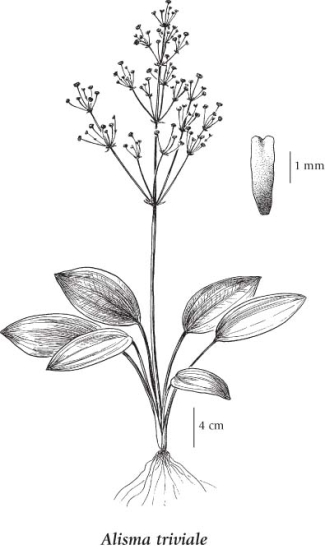American water-plantain (northern water plantain)
Alismataceae (Water-plantain family)
Introduction to Vascular Plants
Introduction click to expand contents
European water-plantain is an introduced emergent wetland species found along stream lake and pond edges that is native to Eurasia. It is now found in North America in Washington, Alaska (USDA 2010) and British Columbia. In British Columbia, it is reported from several locations, mostly in the southern half of the province.
According to the BC Conservation Data Centre (2010) data files "In the past, the native North American species were lumped with this taxon, either as the same species or as variety americanum or triviale... It does appear however that plants with pinkish petals and slightly different styles and anthers are inttoduced plants of the Eurasian A. plantago-aquatica." Plants are up to 1 m in height. Leaves are broadly ovate to broadly lanceolate, flowers and fruits appear in late summer (Flora North America Online 2010). |
Species Information click to expand contents
General:
Perennial aquatic herb from a corm-like stem-base and a fibrous root; stems 20-120 cm tall.
Leaves:
All basal, long-stalked, the blades egg-shaped to broadly lanceolate, 5-15 cm long, 1.5-10 cm wide.
Flowers:
Inflorescence an open, bracteate panicle of long-stalked flowers; petals usually white, 4-6 mm long; sepals green, 2.5-4 mm long.
Fruits:
Achenes, egg-shaped, 2.5-3 mm long.
Notes:
Despite several monographs on Alisma the taxonomy and nomenclature of the above species still remains confused (see Reveal [1977]).
Illustration click to expand contents

If more than one illustration is available for a species (e.g., separate illustrations were provided for two subspecies) then links to the separate images will be provided below. Note that individual subspecies or varietal illustrations are not always available.
Illustration Source: The Illustrated Flora of British Columbia
Ecology click to expand contents
The table below shows the species-specific information calculated from
original data (BEC database) provided by the BC Ministry of Forests and Range.
(Updated August, 2013)
| Site Information |
Value / Class |
||
|
Avg |
Min |
Max |
|
| Elevation
(metres) |
636 | 55 | 790 |
| Slope
Gradient (%) |
0 | 0 | 2 |
|
Aspect (degrees) |
200 | 200 | 200 |
| Soil
Moisture Regime (SMR) [0 - very xeric; 4 - mesic; 8 - hydric] |
7 | 7 | 8 |
| Modal
Nutrient Regime
Class |
D | ||
| #
of field plots species was recorded in: |
10 | ||
| Modal
BEC Zone Class |
IDF | ||
|
All BEC Zones (# of stations/zone) species was recorded in |
BG(1), CDF(1), ICH(1), IDF(4), PP(2), SBS(1) | ||
|
Source:
Klinkenberg 2013
|
|||
Habitat and Range click to expand contents
Status Information click to expand contents
Synonyms click to expand contents
Synonyms and Alternate Names:
Alisma brevipes Greene
Alisma plantago-aquatica subsp. brevipes (Greene) Samuelsson
Alisma plantago-aquatica var. americanum Schult.
Alisma plantago-aquatica var. brevipes (Greene) Victorin
Alisma plantago-aquatica var. triviale
Taxonomic Keys click to expand contents
1. Leaf blades broadly lanceolate to egg-shaped; petals usually white.............Alisma triviale
1. Leaf blades linear, lanceolate or narrowly lanceolate; petals pink, pinkish or white. 2. Inflorescence overtopping the leaves; petals 4.5-6.5 mm long, pink or sometimes purplish-pink..............Alisma lanceolatum 2. Inflorescence usually not overtopping the leaves; petals 2.5-3.5 mm long, pink or white.........Alisma gramineum Source: The Illustrated Flora of British Columbia |